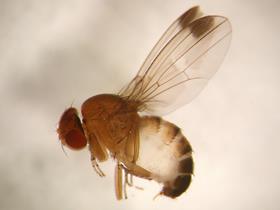
Growers are urged to prepare as a mild winter and early spring could result in an outbreak of fruit fly Spotted Wing Drosophila (SWD).
Laurence Olins, chairman of British Summer Fruits, said that in strawberries, everbearers, and the 60-day crop usually planted in February, will be most susceptible this year as their ripening period during mid- to late-July, coincides with the lifestyle of SWD.
Maincrop strawberries, which are usually over by mid-June, are unlikely to be affected by an outbreak, according to Olins.
He said: “The three-year cross-industry research programme into SWD is a major advance from this time last year. The industry’s knowledge of trapping is better so we are better prepared.
“The one negative is that weather conditions are now more favourable for SWD growing conditions, after a wet winter and mild spring.
“The female fly is in a more advanced reproductive state. It is more in evidence and it is more widespread.”
He added: “There are shorter odds than last year for an outbreak of SWD, but we are more prepared. We are not going to let up.”
Chief entomologist at East Malling Research (EMR), Jerry Cross, said SWD will spread throughout the UK, although attacks will vary in intensity. “There is no silver bullet for growers to completely get rid of SWD in the short to medium term,” he said. “In the long term there is a huge research effort and investment going on across the world.”
Cross said the non-native fly has mainly been found on wild berry hosts, such as blackberries or elderberries. He said that for commercial fruit, raspberries, cherries and blackberries are most susceptible, with strawberries slightly less so.
He emphasised that no pest has faced such a joined-up industry initiative, which far outweighs the efforts made by other affected countries. He described the soft fruit industry as “concerned but vigilant”.
Researchers have established that a closed anaerobic system is an effective way of disposing of fruit waste in orchards, which otherwise increase the risk of SWD infestations. This system allows varying unit sizes of waste to be disposed, although larger anaerobic digestions systems are also suitable.
Last year low numbers of the Asia-originated fly were found on fruit farms in the South East, but cool temperatures kept the population low.
As a result, a comprehensive cross-industry research programme, led by EMR and the James Hutton Institute (JHI), was launched to better understand the lifestyle of the fly.
A new research position solely dedicated to SWD study was created as part of the programme, which has been running since last year.
It monitors 14 fruit farms, six of which are in the south and south east of the country. Farms in the east Midlands, west Midlands and Scotland are also being monitored, although Cross said so far flies have only been found on the farms in the south east of the country.
Cross said two pesticides that are approved in Britain are effective for dealing with SWD, although he admitted that the pest’s ability to become resistance to these chemicals is largely unknown. He said Spinosad should be the first choice for growers at the moment, as it is less broad-sprectrum and less disruptive.
Spinosad can already be used on strawberries and raspberries, with approval due to come through for blueberries and cherries.
Cross said that most of the population of SWD is presumed to be in the wild, so spraying commercial crops with pesticides could create resistance in a small proportion of the total population, but is unlikely to affect the majority.
He added that there is a new pesticide, currently used in the US but not yet approved for use in the UK, that could provide the best method of control for SWD. Although Cross said it may be several years before UK growers can use it, the fact it is on the horizon is good news.
Olins said: “The biggest problem is the danger of complacency. Because we had no outbreak last year, human nature is there is a danger of complacency.
“We would rather the industry know the situation, and be prepared. So we prefer the situation now.”
It is not known how SWD entered the UK, but Cross suggested it is most likely to have been carried on imported fruit. He said this could be through commercial imports, or domestic travel carrying fruit over the UK borders. The SWD monitoring programme is in place in packhouses as well as on farms for this reason.
For more information and guidance on SWD, growers should visit the HDC website.






No comments yet